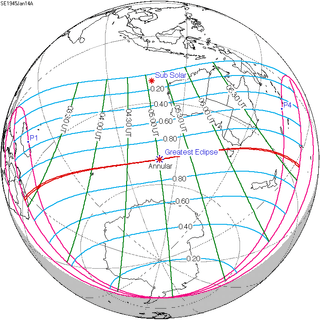Solar eclipse of August 12, 1942
| Solar eclipse of August 12, 1942 | |
|---|---|
 Map | |
| Type of eclipse | |
| Nature | Partial |
| Gamma | -1.5244 |
| Magnitude | 0.0561 |
| Maximum eclipse | |
| Coordinates | 70°24′S 99°54′E / 70.4°S 99.9°E |
| Times (UTC) | |
| Greatest eclipse | 2:45:12 |
| References | |
| Saros | 115 (72 of 72) |
| Catalog # (SE5000) | 9381 |
A partial solar eclipse occurred on August 12, 1942. A solar eclipse occurs when the Moon passes between Earth and the Sun, thereby totally or partly obscuring the image of the Sun for a viewer on Earth. A partial solar eclipse occurs in the polar regions of the Earth when the center of the Moon's shadow misses the Earth.
Related eclipses
Solar eclipses 1942-1946
Each member in a semester series of solar eclipses repeats approximately every 177 days and 4 hours (a semester) at alternating nodes of the Moon's orbit.
Note: The partial solar eclipse on September 10, 1942 occurs in the previous lunar year eclipse set.
| Ascending node | Descending node | |||
|---|---|---|---|---|
| 115 | August 12, 1942 Partial |
120 | February 4, 1943 Total | |
| 125 | August 1, 1943 Annular |
130 | January 25, 1944 Total | |
| 135 | July 20, 1944 Annular |
140 | January 14, 1945 Annular | |
| 145 | July 9, 1945 Total |
150 | January 3, 1946 Partial | |
| 155 | June 29, 1946 Partial | |||
References
See also
External links
- Earth visibility chart and eclipse statistics Eclipse Predictions by Fred Espenak, NASA/GSFC
| Wikimedia Commons has media related to Solar eclipse of 1942 August 12. |
This article is issued from Wikipedia - version of the 5/17/2016. The text is available under the Creative Commons Attribution/Share Alike but additional terms may apply for the media files.
